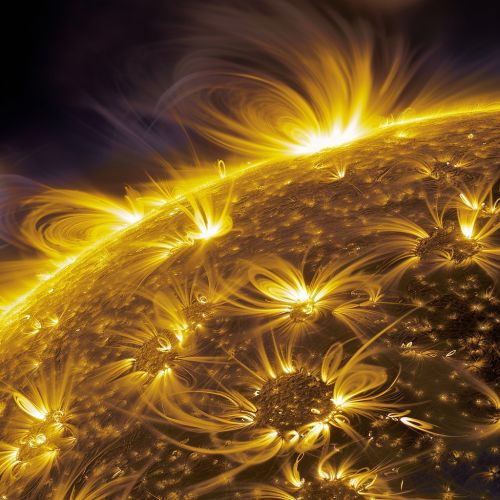Solar cycle
Introduction
The solar cycle is a periodic change in the Sun's activity and appearance such as changes in levels of solar radiation and ejection of solar material, changes in the number and size of sunspots, flares, and other manifestations. They have been observed (by changes in the sun's appearance and by changes seen on Earth, such as auroras) for centuries.


Solar Cycle Basics
The solar cycle is characterized by the periodic change in the sun's activity and related phenomena. The cycle spans approximately 11 years, but this can vary from 9 to 14 years. The cycle was first discovered in 1843 by Samuel Schwabe, a German astronomer, who after 17 years of observations noticed a periodic variation in the average number of sunspots seen from year to year on the solar disk.
Solar Phenomena
The solar cycle is associated with many solar phenomena that are significant in terms of their impact on solar-terrestrial interactions. These include:
Sunspots
Sunspots are temporary phenomena on the photosphere of the Sun that appear visibly as dark spots compared to surrounding regions. They are the most visible attribute of solar activity and are associated with strong magnetic fields.
Solar Flares
Solar flares are sudden flashes of increased brightness on the Sun, usually observed near its surface. Solar flares produce a burst of radiation across the electromagnetic spectrum, from radio waves to x-rays and gamma rays.
Coronal Mass Ejections
Coronal mass ejections (CMEs) are significant releases of plasma and accompanying magnetic field from the solar corona. They often follow solar flares and are normally present during a solar prominence eruption.
Cycle Phases
The solar cycle has several distinct phases, which are characterized by specific solar phenomena and levels of solar activity.
Minimum Solar Activity
During the solar minimum, the Sun emits a minimum amount of solar radiation. Sunspots and solar flares are rare during this time, but it's also when coronal holes appear.
Maximum Solar Activity
The solar maximum is the period of greatest solar activity in the solar cycle of the Sun. It is characterized by an increase in the number and size of sunspots and is often associated with solar phenomena such as solar flares and CMEs.
Impact on Earth
The solar cycle has significant effects on Earth's climate and atmospheric phenomena. It influences the intensity of the solar wind, which in turn impacts Earth's magnetosphere and can create geomagnetic storms. These storms can affect power grids, satellites, and radio communications.
Predicting Solar Cycles
Predicting the behavior of the solar cycle is an important aspect of solar astronomy. However, despite decades of study, predictions remain uncertain. Various prediction methods have been developed based on physical models and statistical methods.
